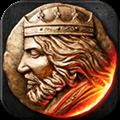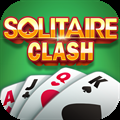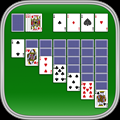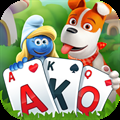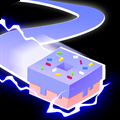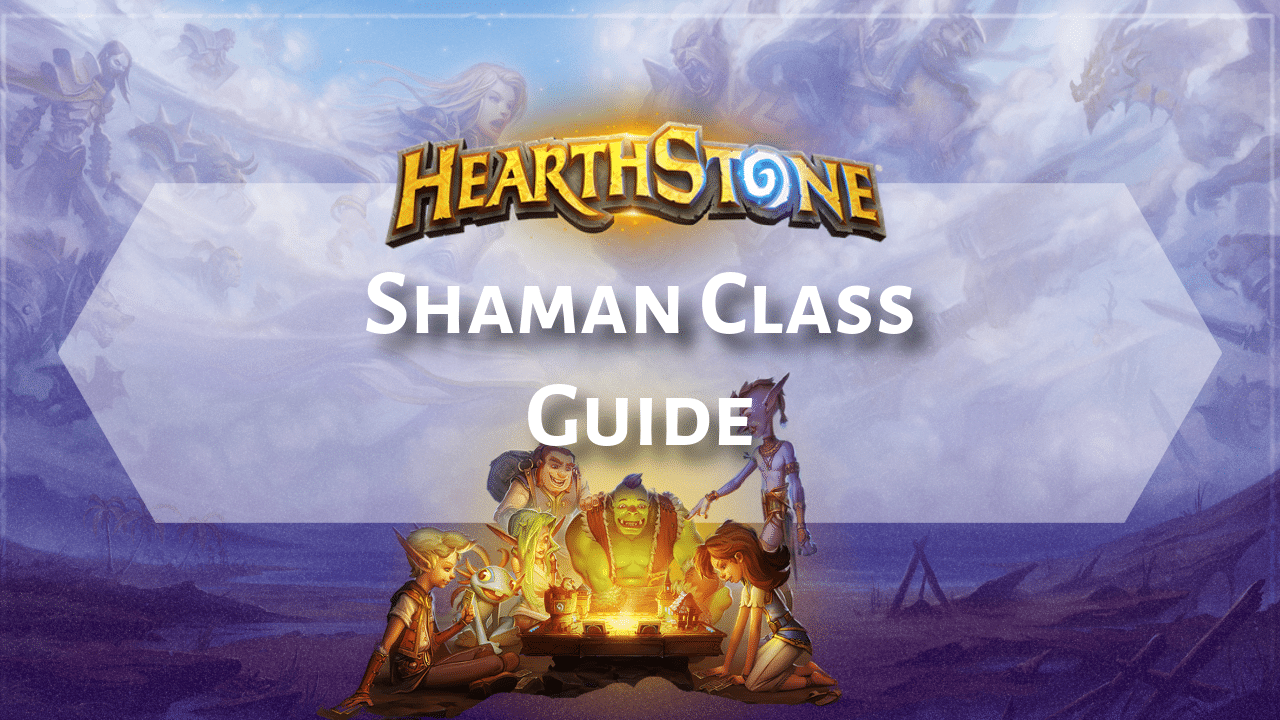
Hearthstone Shaman Class Guide:Introduction to the Shaman Class
The Shaman class in Hearthstone is a versatile and dynamic choice, drawing its power from the primal elements of air, earth, fire, and water. Shamans are depicted as those who can harness and balance these chaotic forces, using them to control the board, unleash devastating spells, summon powerful minions, and enhance their allies. This elemental connection is central to the class’s unique mechanics, offering a variety of strategic options that make Shaman both flexible and engaging to play.
The default hero representing the Shaman class is Thrall, but players can also unlock Morgl the Oracle as a cosmetic alternative. Two core aspects define the Shaman class: Totems, which are essential tools for channeling elemental power and providing persistent effects, and Communication with the Elements, reflected in the class’s diverse card pool featuring elemental minions, nature-based spells, and abilities that influence the battlefield. These mechanics allow Shamans to adapt to different playstyles, making them a compelling choice for players who enjoy both control and aggression.
Shaman’s Hero Power: Totemic Call
The Shaman’s Hero Power, Totemic Call, allows the Shaman to summon a random basic totem for two mana, each providing a unique effect that can influence the game. While individually weak, these totems contribute to board presence and can create powerful synergies. The four basic totems that can be summoned are Healing Totem, which restores 1 Health to all other friendly minions at the end of the turn; Searing Totem, a simple 1/1 minion; Stoneclaw Totem, a 0/2 minion with Taunt that can shield other minions; and Wrath of Air Totem, which grants +1 Spell Damage to enhance spell-based strategies.
The summoning is random, with an equal 25% chance of summoning any of the four, provided that totem is not already on the board. If a totem of that type is already present, it cannot be summoned again. This randomness introduces both flexibility and unpredictability, making the Hero Power a dynamic tool in the Shaman’s arsenal. A well-timed Wrath of Air Totem can significantly boost spell damage, while a Stoneclaw Totem can provide critical protection. Despite the variance, repeated uses of Totemic Call contribute to long-term board control and synergy with Shaman cards that benefit from totems, reinforcing the class’s identity as a master of elemental forces.
Key Mechanics Unique to Shaman
Several key mechanics define the Shaman class, setting it apart with unique gameplay strategies. Overload is a signature mechanic that allows Shamans to play powerful cards at a reduced upfront mana cost, with the drawback of temporarily locking mana crystals on the next turn.
This “buy on credit” system enables strong tempo plays but requires careful resource management to avoid being hindered in future turns. Certain cards, like Unbound Elemental, benefit from Overload by gaining additional stats when Overload cards are played. Totems are another core feature of the Shaman class, typically appearing as inexpensive minions with smaller stats but providing ongoing utility.
The Totemic Call Hero Power summons one of four basic totems, while additional totems like Flametongue Totem, which buffs adjacent minions, and Mana Tide Totem, which grants extra card draw, expand the Shaman’s strategic options. Many Shaman decks capitalize on totem synergies, with careful minion positioning playing a role in maximizing effects. Evolution is another defining mechanic, allowing Shamans to transform minions into random ones that cost one mana more. Cards like Evolve and Muck Pools enable this transformation, leading to potentially powerful upgrades but with an element of unpredictability.
While evolution mechanics can create a formidable board state, they also carry the risk of generating weaker or situationally ineffective minions. Lastly, Shaman is one of the few classes with access to Freeze effects, offering tools like Windchill and Frostbite to stall enemy threats and disrupt the opponent’s board. Together, these mechanics make Shaman a highly adaptable class that rewards creative deck-building and strategic decision-making.
Common Shaman Deck Archetypes and Strategies
The Shaman class supports a variety of effective deck archetypes, each offering a distinct playstyle suited to different strategies. Aggro/Token Shaman focuses on quickly establishing board control with a swarm of small minions, including totems, and leveraging buff spells like Bloodlust and Flametongue Totem to deliver burst damage. It aims to maintain tempo and pressure the opponent before they can stabilize.
Mid-Range Shaman balances early removal with strong mid-game threats, using cards like Fire Elemental to maintain board control and steadily apply pressure. This archetype is adaptable, able to shift between aggression and control depending on the matchup. Control Shaman relies on powerful removal spells like Hex, Lightning Bolt, and Lightning Storm to keep the board clear, often including healing effects and late-game win conditions to outlast opponents. Board wipes are crucial in this deck, making it particularly effective against aggressive strategies.
Evolve Shaman builds around the Evolution mechanic, using cards like Evolve and Muck Pools to transform weaker minions into stronger ones, often generating a board of upgraded threats from token generators. While powerful, this archetype depends on the randomness of evolution effects. Nature Shaman capitalizes on nature spells, often incorporating Spell Damage minions to amplify burst potential. This playstyle focuses on cycling through spells for efficient removal or high burst damage in a single turn.
Elemental Shaman centers around Elemental synergy, playing minions that activate powerful effects when played in succession. Cards like Granite Forgeborn, Windchill, and Brilliant Macaw provide tempo advantages, while variations such as Aggro Elemental Shaman prioritize early-game aggression. Even Shaman, primarily played in Wild format, is built around even-cost cards to take advantage of Genn Greymane’s effect, reducing the cost of the Hero Power to one mana. This allows for consistent Totemic Call usage, supporting a board-focused strategy with efficient minions and removal. Each archetype showcases the Shaman’s adaptability, making the class a versatile choice for players who enjoy a mix of board control, spell synergies, and explosive turns.
Strengths of the Shaman Class
The Shaman class excels in several key areas, making it a formidable choice for players who enjoy flexible and powerful strategies. One of its greatest strengths is board control, with access to potent single-target removal like Hex and a variety of efficient AoE spells such as Lightning Storm, Maelstrom Portal, Volcano, and Elemental Destruction, allowing Shamans to manage enemy threats effectively. Another defining trait is the high snowball potential, as seemingly weak boards can become overwhelming through buffs like Flametongue Totem, Bloodlust, and Windfury, as well as the Evolve mechanic, which can transform small minions into powerful threats.
Shamans also have significant burst damage options, utilizing direct damage spells like Lightning Bolt and Lava Burst, alongside weapon-based combos such as Doomhammer with Rockbiter Weapon, to close out games unexpectedly. Finally, versatility and adaptability define the class, as Shamans have access to a broad range of cards that support multiple archetypes, allowing them to adjust their strategy depending on the matchup and shifting meta. Whether controlling the board, setting up explosive turns, or delivering sudden bursts of damage, the Shaman class remains a dynamic and rewarding choice for strategic play.
Weaknesses of the Shaman Class
Despite its strengths, the Shaman class also has notable weaknesses that can make certain matchups challenging. One of its primary drawbacks is its reliance on board control—many Shaman archetypes, particularly Aggro and Mid-Range, struggle significantly if they lose their board presence. Without minions to buff or evolve, their game plan can quickly collapse.
Additionally, the Overload mechanic, while enabling powerful tempo plays, can create a weakened following turn, leaving the Shaman vulnerable to counterattacks and limiting their ability to develop the board. Mismanaging Overload can lead to significant disadvantages. Another challenge is the inconsistency due to randomness, as the Hero Power’s totem summons and the Evolve mechanic introduce unpredictability.
The totem summoned may not be the most useful one for the situation, and evolved minions can sometimes result in suboptimal outcomes. Lastly, potential lack of consistent card draw can hinder certain Shaman archetypes, particularly aggressive ones, causing them to run out of resources quickly. While draw tools like Mana Tide Totem exist, they are often vulnerable to removal, making resource generation unreliable. Managing these weaknesses effectively is crucial to mastering the Shaman class and maximizing its potential in different strategies.
Key Shaman Cards
Shaman has a diverse set of key cards that define its playstyle, categorized by their function. Removal spells allow Shamans to control the board efficiently, with Hex transforming enemy minions into harmless frogs, Lightning Bolt providing cheap direct damage, and Lightning Storm offering AoE to clear wide boards. Cards like Rockbiter Weapon and Frostbite also serve as flexible removal options, while Lock On provides targeted damage.
Minions play a crucial role in various Shaman strategies, with Fire Elemental delivering direct damage upon summoning, Flametongue Totem enhancing adjacent minions’ attack, and Mana Tide Totem providing valuable card draw. Other key minions include Unbound Elemental, which gains stats when Overload cards are played, Granite Forgeborn for Elemental synergy, Sleet Breaker for Freeze utility, and Brilliant Macaw and Bolner for Battlecry effects.
Muck Pools further supports the Evolution mechanic, transforming friendly minions into stronger ones. Spells and buffs help enhance Shaman’s board presence and burst potential, with Bloodlust enabling massive damage swings, Windfury doubling a minion’s attack opportunities, and Windchill offering both Freeze and card draw. Evolve remains a defining spell, reshaping minions into higher-cost threats. Weapons provide additional removal and burst damage, with Doomhammer offering multiple attacks per turn and Stormforged Axe granting early-game control. These cards highlight the Shaman class’s versatility, allowing for aggressive, control, and combo-oriented strategies depending on the deck composition.
Mulligan Strategies
When mulliganing as a Shaman, the primary goal is to secure a strong early game by keeping low-cost minions to establish board presence and early removal spells to manage the opponent’s threats. The ideal mulligan choices depend on the specific archetype being played and the matchup at hand. Aggressive Shaman decks should prioritize early-game minions that can apply pressure, while more control-oriented builds benefit from efficient removal spells or card draw to maintain resources.
In Elemental Shaman, it is often beneficial to keep early Elemental minions to ensure consistent activations of Elemental synergies and maintain tempo. Cards like Granite Forgeborn can be valuable as they provide cost reduction on future Elementals, allowing for strong mid-game turns. Understanding the opponent’s likely strategy and adjusting the mulligan accordingly can significantly improve the chances of securing a favorable early-game position.
Gameplay Tips and Strategies
When playing Shaman, strategic planning and resource management are key to maximizing the class’s strengths while mitigating its weaknesses. Managing Overload carefully is crucial—always consider how Overload will affect your next turn’s mana and avoid overloading yourself unless you have a clear follow-up plan. Utilizing totems strategically can provide lasting advantages; think about which totem would be most beneficial for your current board state and look for synergies with cards like Flametongue Totem or Mana Tide Totem.
Recognizing opportunities for burst damage is essential—keeping track of potential lethal setups with spells, weapons, and board buffs like Bloodlust can help close out games efficiently. Additionally, being aware of Shaman’s weaknesses can inform decision-making; opponents who capitalize on Overload turns or clear the board consistently can disrupt a Shaman’s strategy. When playing against Shaman, maintaining board control by removing totems and small minions can limit their ability to snowball with buffs or evolve effects.
Watching for Overload turns can also present opportunities to seize board advantage. Finally, playing around key removal spells like Hex and AoE effects by not overcommitting too many crucial minions to the board can help prevent devastating tempo swings. Mastering these principles will improve overall performance with Shaman, making gameplay more consistent and effective.
Budget and Basic Shaman Decks
A basic Shaman deck relies on fundamental cards unlocked by leveling up the class, focusing on board control and efficient removal. Spells like Rockbiter Weapon provide early removal, while Hex is essential for neutralizing larger threats.
Minions such as Shattered Sun Cleric, which buffs a friendly minion, Chillwind Yeti, a solid four-mana minion with strong stats, Boulderfist Ogre, a straightforward but powerful six-mana minion, and Fire Elemental, which combines strong stats with immediate damage, form the backbone of a basic deck. Token-based strategies can be effective by using cards like Murloc Tidehunter and Razorfen Hunter to generate multiple minions, setting up powerful buffs from Flametongue Totem, Stormwind Champion, and Bloodlust for a potential finisher.
Budget versions of the deck can refine these strategies by incorporating common and rare cards that enhance synergies and provide additional value, making it an accessible and effective choice for new players looking to master the Shaman class.
Shaman in Different Game Modes
Shaman has remained a viable class in both Standard and Wild formats, with its competitive standing shifting based on new card releases and evolving metas. In Wild format, Even Shaman has been a consistently strong archetype, utilizing only even-cost cards to benefit from the upgraded hero power provided by Genn Greymane, allowing for stronger early-game board control.
The class’s diverse mechanics, including Overload, Totems, and the Evolution mechanic, have contributed to its adaptability across different metas. In solo adventure modes like Dungeon Run, Shaman has access to unique card buckets and treasures that enable powerful and unconventional builds. These modes often emphasize Shaman’s ability to generate wide boards, capitalize on spell synergies, or unleash devastating burst damage through specialized deck-building opportunities. Whether in constructed play or PvE adventures, Shaman’s versatility continues to make it a compelling and dynamic choice.
Counters to Shaman
Shaman can be effectively countered by decks and strategies that exploit its weaknesses. Decks with strong and consistent board clears can disrupt Shaman’s reliance on maintaining a wide board for buffs or evolve effects, preventing them from snowballing their advantage. Aggressive decks that apply constant pressure can capitalize on Shaman’s Overload mechanic, punishing turns where the Shaman has reduced mana availability and limiting their ability to respond effectively.
Strategies that minimize the impact of Totems can be highly effective in weakening the Shaman’s ability to generate long-term value. Since many Shaman decks rely on Totems for incremental advantages—whether through passive effects, buff synergies, or spell damage amplification—quickly removing them prevents the Shaman from building momentum. This is particularly important against archetypes like Totem Shaman, which can snowball out of control if left unchecked.
Efficient removal tools that target multiple small minions, such as low-cost area-of-effect spells or minions with Rush, can help clear Totems before they become problematic. Additionally, decks that focus on direct damage, spell-based strategies, or OTK (One Turn Kill) combos can sidestep the need for extended minion combat, reducing the effectiveness of the Shaman’s hero power and Totem synergies.
Another key tactic against Shaman is playing around their powerful removal spells like Hex, which can completely negate a strong minion, and their area-of-effect spells, which can wipe out a wide board. Instead of overcommitting multiple high-value minions at once, a more measured approach ensures that a single board clear does not leave you with no resources to recover.
Against Shamans running Lightning Storm or Volcano, staggering minion deployment or maintaining a mix of high-health and low-health minions can make it harder for them to clear everything efficiently. If playing a deck that relies on key threats to close out the game, it’s best to bait out Hex and other hard removal on less critical minions first before committing your strongest win conditions. By anticipating and adapting to Shaman’s board control tools, players can maintain pressure while avoiding costly overextensions. Understanding these weaknesses and adjusting your play accordingly will significantly improve the chances of securing victory against a Shaman opponent.




